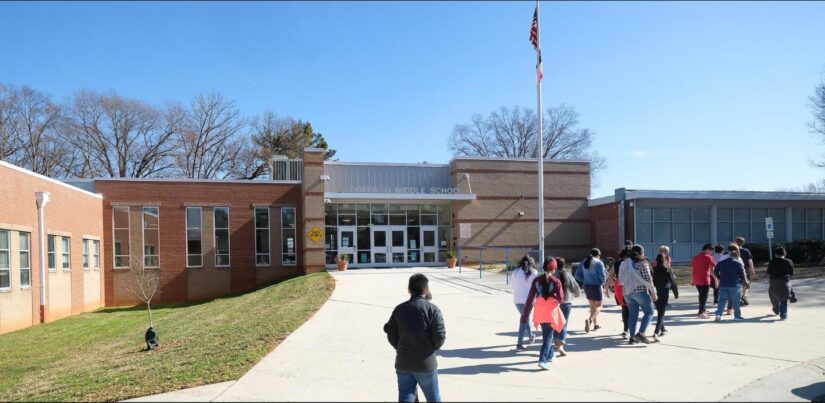‘Low-Hanging Fruit’: Thousands of Same-Race Schools Within Miles of Each Other
Contrary to the claims of integration opponents who cite lengthy bus rides, 7,800 highly segregated schools lie less than five miles from each other

Get stories like this delivered straight to your inbox. Sign up for The 74 Newsletter
Sedgefield Middle School and Alexander Graham Middle School are just a few miles apart and feed into the same high school. But residents of Charlotte, North Carolina know they have long been two very different campuses.
“They were both segregated middle schools,” said Akeshia Craven-Howell, who until recently was assistant superintendent of Charlotte-Mecklenburg Schools, overseeing student school assignments.
“Sedgefield Middle School serves students primarily from lower socioeconomic communities and Alexander Graham serves students from communities with primarily higher socioeconomic factors.”
But in 2019, the district, fueled by strong parent advocacy, tried something new. It mixed the two buildings’ student populations by creating a combined attendance area and rearranging which elementary schools sent students to which middle schools.
“We were able to create two middle schools that were much more socioeconomically diverse,” said Craven-Howell, who now works as an advisor for Bellwether Education Partners.

Across the country, thousands of schools closely resemble the segregated Sedgefield and Alexander Graham, a new U.S. Government Accountability Office report reveals.
Over 7,800 predominantly same-race schools, it finds, are located within just five miles of a different same-race school. Widening the radius to 10 miles swells the total to over 13,500.
Those cases may represent “low-hanging fruit” for integration efforts, said Craven-Howell.

“It doesn’t require a significant trade-off with home-to-school distance, which I think is often a barrier for some families when they think about school diversity.”
A strong majority of parents say they would like to see schools increase their racial and socioeconomic balance, but support wanes when the undertaking involves busing programs or further travel, according to polling from The Century Foundation. Opponents of integration schemes often cite lengthy bus rides in their resistance to the plans.
In many cases, however, such a sacrifice is not required, said Richard Kahlenberg, the organization’s director of K-12 equity.
“It’s so often true that people will say, ‘We would love integrated schools, but it’s just not logistically possible because of distances,’” he told The 74.
That’s often a false dichotomy.
“Distance, in many cases, is not an excuse for segregation,” he said.
‘Wrong side of the tracks’
Roughly a third of the 13,500 schools identified in the federal report belong to the same school system as their counterpart campus, meaning possible desegregation efforts would lie directly in the hands of district leaders.
Some 9 in 10 have a pair across district lines, which can entrench racial imbalances between campuses, said report co-author Jacqueline Nowicki. (The percentages, 32% and 90%, add to more than 100% because some schools have pairs both within and outside of their district.)
“Where we choose to draw school district boundaries, … that matters a lot as to where kids are going to schools,” the GAO education director told The 74.
“School district lines are not God-given,” added Kahlenberg. Florida and several other states, for example, use large county-based school systems to help balance their classrooms racially and socioeconomically.
Using 2020-21 data, the most recent figures available from the U.S. Education Department’s Common Core of Data, Nowicki’s team found that over a third of U.S. students — roughly 18.5 million — attend predominantly same-race schools. They applied the “predominantly same-race” label to schools where students of a single race or ethnicity make up at least 75% of the enrollment. The percentage of highly segregated U.S. schools decreased slightly from 2016, the last time the GAO investigated the issue. But given increases in diversity over that time span, including more students who identify as Asian or Hispanic, the researcher doesn’t see the numbers as particularly encouraging.
The share of students of color attending highly segregated schools, which tend disproportionately to also be high-poverty schools, ticked up, she pointed out. Those campuses, on average, have worse academic outcomes compared to their wealthier peers.

“What does it mean, in a country that’s increasingly becoming more diverse, to have large portions of kids going to school only with other kids who look like themselves?” said Nowicki.
The reasons why the U.S. continues to have divided classrooms stretch far into the past, her agency’s report explains. In one major example, redlining, a federal 1930s practice of denying home loans to borrowers of color while supplying them to white candidates, systematically reduced Black homeownership and codified racial divisions between neighborhoods. The impacts of the discriminatory policy continue to haunt education outcomes to this day.
“This is where phrases like ‘the wrong side of the tracks’ have come from,” said the GAO director.
‘The city that made desegregation work’
In the case of Charlotte-Mecklenburg, the recent school integration push comes on the heels of a back-and-forth history after Brown v. Board of Education.
Charlotte was once known as “the city that made desegregation work.” After the landmark 1971 Swann v. Charlotte-Mecklenburg Board of Education ruling upheld the district’s busing scheme, the city’s integration plan became a model for cities across the southern U.S. — which in the current day are less segregated than other regions of the country.
“Charlotte-Mecklenburg’s proudest achievement of the past 20 years is not the city’s impressive new skyline or its strong, growing economy. Its proudest achievement is its fully integrated schools,” the Charlotte Observer editorial board stated in 1984.

But after a 1999 decision struck down court-mandated desegregation requirements, campuses in the area quickly became more and more divided — with starkly unequal outcomes between its 180 schools.
In 2014, the area received sobering news: a study by Harvard University researchers ranked Charlotte dead last out of 50 American cities in upward mobility, or the likelihood of low-income youth rising out of poverty.
The report blamed two main factors for the abysmal assessment: racial segregation and school quality.
“One of the predictors of low levels of social mobility is school and neighborhood segregation,” explained Kahlenberg.
When the 140,000-student district resurrected decades-old conversations on how to integrate its schools, the memory of past efforts remained vivid for many residents. There was an appetite for the changes, but they still proved difficult, said Craven-Howell. In merging communities that had different socioeconomic makeups, the district had to be careful to make sure the voices and needs of wealthier parents did not drown out those of lower-income families.
But the effort has been a success thus far, said the former Charlotte-Mecklenburg administrator, and they have begun to move the needle on integration. However, they affect only a small share of campuses. She hopes the district will continue to build on its progress and “identify opportunities to replicate some of the great work that was done six years ago,” the last time it reviewed student school assignments.
Charlotte is not alone in the push. The district is a member of The Century Foundation’s Bridges Collaborative, a network of 27 school systems, 17 charter school networks and 13 housing organizations across the country undertaking efforts to chip away at segregation in their schools and communities. Though they account for only a tiny fraction of the 13,500 segregated school pairs identified by the GAO report, Craven-Howell believes they demonstrate what’s possible.
“There are districts all over the country who are thinking about [integration], who are trying things,” she said. “It’s not the case that a district has to embark on this work without there being any models or examples to look to.”
And as for Sedgefield and Alexander Graham, the Charlotte middle schools that combined their student bodies in 2019, the change has worked, said Craven-Howell.
“People don’t think about it as the two schools and the two communities that paired. They really have become a single community.”
Get stories like these delivered straight to your inbox. Sign up for The 74 Newsletter

;)
